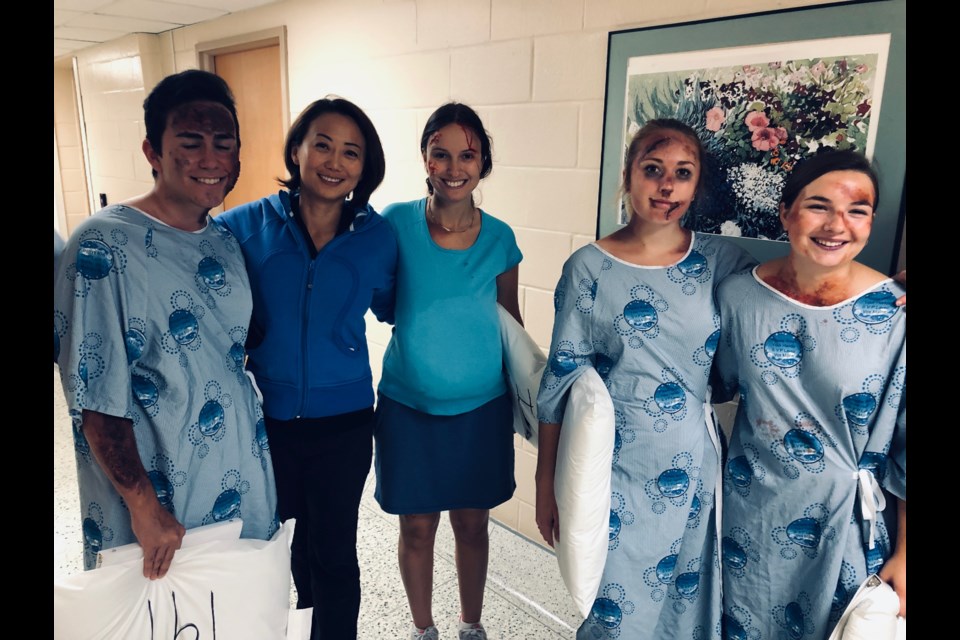Collingwood’s General and Marine Hospital (CGMH) was the site of an elaborate simulation this weekend featuring the gory makeup effects of local high school students.
Collingwood’s doctors, nurses, and health care professionals became teachers this Friday, Saturday, and Sunday for two trauma courses facilitated by the Rural Ontario Medical Program.
Friday and Saturday (Sept. 20 and 21) saw about 40 physicians and residents from across Canada and the U.S. participate in the Advanced Trauma Life Support course, which included a simulation involving live actors and the makeup talents of the Collingwood Collegiate Institute cosmetology class.
The course is required for Emergency Room health care staff and can often be very expensive. In Collingwood, the Rural Ontario Medical Program (ROMP) subsidizes the courses. The two-day course simulates various crises with live actors and mannequins to allow participants to practice and optimize their response in emergencies.
The courses are the work of a “village,” and bring “exceptional” training in the local area, according to Michelle Hunter, ROMP’s manager.
ROMP facilitates and subsidizes the training, which is accredited. The Collingwood General and Marine Hospital provides the facilities. The specialized simulation technology was purchased thanks to community support through the CGMH Foundation. CCI cosmetology students contribute their talents to make it look real. Local physician teachers and faculty run the training programs, and medical students play the role of trauma victims.
On Sunday. Sept. 22, a group of ten learners will take a course designed in Collingwood by Dr. Jesse Guscott. The course is called SCORE (Simulating Crisis for Optimal Response in Emergencies), and it uses an advanced technology mannequin that is remotely controlled by a team of doctors and nurses who will be teaching the program.
Guscott, a physician at CGMH since 2006, compared the mannequin to a “flight simulator” but for medical emergencies.
“The program is designed to expose learners and health care professionals to a variety of uncommon but high-risk situations,” said Guscott.
The mannequin can provide feedback to the trainers and the trainees. It has a heartbeat and simulated lungs, and it can even talk.
Those taking the course are put into teams and sent into a room with the mannequin.
“Then bad things happen to the mannequin,” said Guscott.
Following the simulation, a team of doctors and nurses from CGMH will talk to the program participants about what went well and what did not.
Guscott said some of the simulations are stock emergencies like a cardiac arrest. Other emergencies are based on his cases, or those that have come through the CGMH.
“It’s designed by rural health care practitioners for rural health care practitioners,” he said. “Rural physicians and nurses need to be able to work under a wider scope of practice ... Health care professionals in rural areas are asked to care for patients who are very sick and the resources are different.”
For example, if a person is a victim of a car crash near St. Michael’s Hospital in Toronto, there would likely be a team of 20 health care practitioners including several specialists in the room assembled before the patient arrives.
In Collingwood, an emergency room physician and nurse might be on their own for the first 15 minutes or so. But at CGMH those nurses and doctors will still do a lot of the work of a St. Michael's trauma team.
While in a larger hospital in a city centre, a surgeon might be ready and waiting to insert a chest tube in an emergency, at a rural or community hospital like CGMH, an ER doctor has the skills to insert a chest tube.
The SCORE program teaches its participants to be able to handle those life-saving procedures in an emergency.
“In a number of ways, the people I work with inspired the course,” said Guscott. “The skills of the people whom I work with at this hospital are really great.”
The SCORE program will take 10 participants through simulations and they will be led by a team of eight CGMH staff.
Guscott said his program has been running for about one-and-a-half years. Guscott and the CGMH team will run the program from Collingwood, and at other hospitals across the province to train and test emergency room teams and their systems in their own facility.
